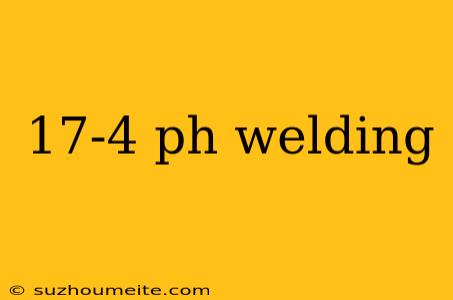17-4 PH Welding: A Comprehensive Guide
Introduction
17-4 PH is a type of precipitation-hardening stainless steel that is widely used in various industries, including aerospace, chemical processing, and power generation. Its high strength, corrosion resistance, and excellent weldability make it an ideal choice for many applications. However, welding 17-4 PH can be challenging, and require specific techniques and procedures to achieve high-quality welds. In this article, we will discuss the basics of 17-4 PH welding, its advantages, and best practices for welding this alloy.
Chemical Composition
17-4 PH is a chromium-nickel-copper alloy that contains:
- 15-17% Chromium (Cr)
- 3-5% Nickel (Ni)
- 3-5% Copper (Cu)
- 0.07% Carbon (C)
- 1% Manganese (Mn)
- 1% Silicon (Si)
The addition of copper and niobium (Nb) enhances the alloy's precipitation hardening properties, allowing it to achieve high strength and corrosion resistance.
Welding Processes
Several welding processes can be used to weld 17-4 PH, including:
Gas Tungsten Arc Welding (GTAW)
GTAW is a popular process for welding 17-4 PH due to its precision and control. It is commonly used for thin sections and intricate weldments.
Gas Metal Arc Welding (GMAW)
GMAW is a semi-automatic process that uses a continuous wire feed. It is suitable for thicker sections and offers higher productivity than GTAW.
Shielded Metal Arc Welding (SMAW)
SMAW, also known as stick welding, is a manual process that uses a consumable electrode. It is often used for repair and maintenance work.
Welding Techniques
To achieve high-quality welds in 17-4 PH, the following techniques should be employed:
Cleanliness
Ensure the base metal and welding area are clean and free of oil, dirt, and moisture.
Joint Preparation
Prepare the joint with a 30-45° bevel angle and a root face of 1/8 inch.
Welding Parameters
Use the following welding parameters:
- GTAW: 100-150 amps, 10-15 volts, and a travel speed of 3-6 inches per minute.
- GMAW: 150-250 amps, 20-25 volts, and a travel speed of 6-10 inches per minute.
- SMAW: 100-150 amps, 15-20 volts, and a travel speed of 3-6 inches per minute.
Heat Treatment
Perform a post-weld heat treatment (PWHT) at 1025°F (550°C) for 1-2 hours to relieve stresses and achieve optimal mechanical properties.
Advantages and Applications
The advantages of 17-4 PH welding include:
- High strength-to-weight ratio
- Excellent corrosion resistance
- Good weldability
- Low distortion
17-4 PH is commonly used in:
- Aerospace components (e.g., landing gear, engine mounts)
- Chemical processing equipment (e.g., reactors, heat exchangers)
- Power generation components (e.g., turbine blades, compressor blades)
Conclusion
Welding 17-4 PH requires careful attention to joint preparation, welding parameters, and heat treatment. By following the guidelines outlined in this article, welders can achieve high-quality welds that meet the demanding requirements of various industries.
